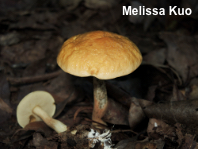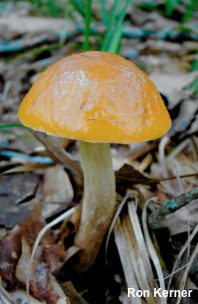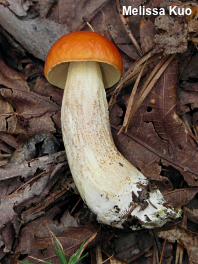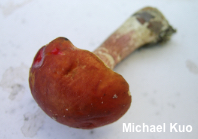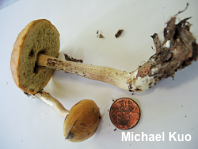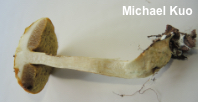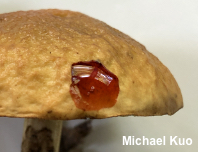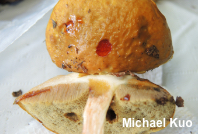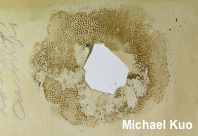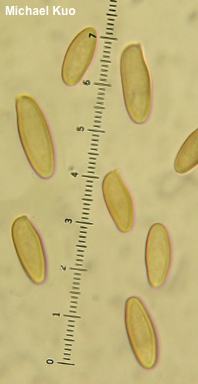| Major Groups > Boletes > Leccinum > Leccinum longicurvipes |

|
Leccinum longicurvipes [ Basidiomycota > Boletales > Boletaceae > Leccinum . . . ] by Michael Kuo Originally described from Great Smoky Mountains National Park, Leccinum longicurvipes is a mycorrhizal symbiont with oaks throughout eastern North America. It is a slender and fairly small species with a sticky (when fresh) orange to orange-brown cap, a dull yellowish pore surface that does not bruise blue when damaged, and a long whitish stem adorned with fine, pinkish to pinkish brown scabers. A drop of KOH on the cap surface produces a bright red reaction, which can help to separate Leccinum longicurvipes from look-alike species—the closest of which may be Hemileccinum subglabripes, which is negative or pinkish with KOH and also differs in its yellower flesh and stem, less conspicuous scabers, and very different pileipellis under the microscope. Boletus longicurvipes is a previous name. Thanks to Ron Kerner for documenting, collecting, and preserving Leccinum longicurvipes for study; his collections are deposited in The Herbarium of Michael Kuo. Thanks to the U. S. National Fungus Collections (BPI) for facilitating study of the type collection. Description: Ecology: Mycorrhizal with oaks; growing alone or gregariously; summer and fall; widely distributed in North America east of the Great Plains, but more common in the Appalachian Mountains. The illustrated and described collections are from Indiana, Kentucky, Missouri, North Carolina, Ohio, and Texas. Cap: 2.5–5 cm; convex, becoming broadly convex; sticky when fresh; bald; often a little wrinkled; orange to brownish orange or brownish golden—or sometimes orangish brown; without a sterile overhanging margin. Pore Surface: Dull yellow, becoming dull grayish yellow; not bruising, or bruising a little brownish; 2–3 angular pores per mm at maturity; tubes to 15 mm deep; by maturity usually depressed at the stem. Stem: 4–10 cm long; 5–20 mm thick; gradually tapering to apex; often a little curved; finely scurfy with pale brown to reddish brown scabers; sometimes becoming nearly reticulate (widely and longitudinally), especially near the base; ground color dull yellow; basal mycelium white. Flesh: Whitish to pale yellowish; not staining on exposure, or becoming a little pinkish in the stem; sometimes slightly bluing in the stem base. Odor and Taste: Not distinctive. Chemical Reactions: Ammonia negative to pinkish or pale red on cap surface; negative to pinkish on flesh. KOH bright cherry red on cap surface; dull yellow to orangish on flesh. Iron salts dull gray or bluish gray on cap surface; negative or bluish gray on flesh. Spore Print: Olive brown. Microscopic Features: Spores 12–19 x 4–6.5 µm; fusiform; smooth; yellowish to dull golden in KOH; inamyloid (dark yellow) in Melzer's. Basidia 25–34 x 5–12 µm; clavate; 4-sterigmate. Hymenial cystidia 30–50 x 6–12 µm; fusiform or lageniform with a long neck; smooth; thin-walled; hyaline in KOH. Pileipellis an ixocutis or collapsing ixotrichoderm of elements 5–7.5 µm wide, smooth, thin-walled, hyaline to yellowish in KOH; terminal elements mostly cylindric with rounded apices but occasionally subclavate or irregular. Caulocystidia in bundles with caulobasidia; fusiform to lageniform, sometimes with a long neck; 22–80 x 10–20 µm; hyaline in KOH. REFERENCES: (Snell & A. H. Smith, 1940) M. Kuo & B. Ortiz-Santana, 2020. (Smith & Theris, 1971; Smith, Smith & Weber, 1981; Weber & Smith, 1985; Phillips, 1991/2005; Both, 1993; Bessette et al., 2000; Roody, 2003; den Bakker & Noordeloos, 2005; Nuhn et al., 2013; Kuo & Methven, 2014; Bessette et al., 2016; Woehrel & Light, 2017; Kuo & Ortiz-Santana, 2020.) Herb. Kuo 10200708, 07171001, 09241111, 09121406, 09201403, 08091911. Herb. EIU ASM 10042, ANM 446. Herb. BPI 781144 (W. H. Snell 897, holotype). This site contains no information about the edibility or toxicity of mushrooms. |
© MushroomExpert.Com |
|
Cite this page as: Kuo, M. (2020, January). Leccinum longicurvipes. Retrieved from the MushroomExpert.Com Web site: http://www.mushroomexpert.com/leccinum_longicurvipes.html |
